The 2016 Razer Blade Pro Review
by Brandon Chester on March 6, 2017 8:00 AM EST- Posted in
- Laptops
- Razer
- Razer Blade Pro
sRGB Accuracy
The Razer Blade Pro uses a 17.3" 3840x2160 display. Like almost all of Razer's laptops, this is not an IPS panel. I suspect that it's some sort of vertical alignment tech, but I've been unable to track down the specifics of the panel even though it's known to be a display from Sharp. However, the viewing angles on the Blade Pro are very good, and it doesn't suffer from the yellow tint when viewed off-axis that I noticed on Josh's 14-inch 2014 Blade.
Razer also advertises that the display covers 100% of the Adobe RGB color gamut. I've talked about the issues of using wide-gamut displays on non-color managed platforms so many times in the past that I've grown tired of it, and I'll save it for later when it's most directly relevant. The use of Adobe RGB does necessitate a change from the standard laptop display workflow, so I've split the testing into two sections. This section goes through the standard sRGB analysis to see how things are reproduced in the standard gamut used by almost all computer content, and the next page covers accuracy relative to Adobe RGB and then goes through a greyscale calibration with that gamut as the target.
As always, measurements are done with an X-Rite i1Pro 2 spectrophotometer, except for black level measurements which are done with an X-Rite i1Display Pro colorimeter. Data is profiled and analyzed using SpectraCal's CalMAN software.
Brightness and Contrast
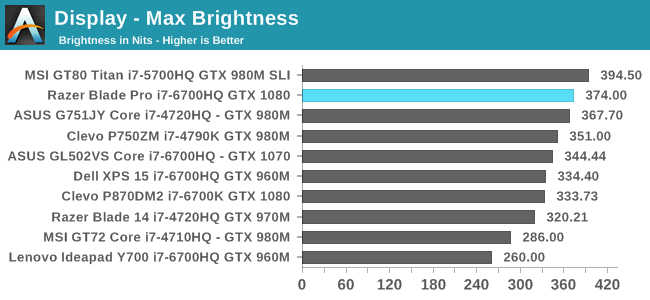
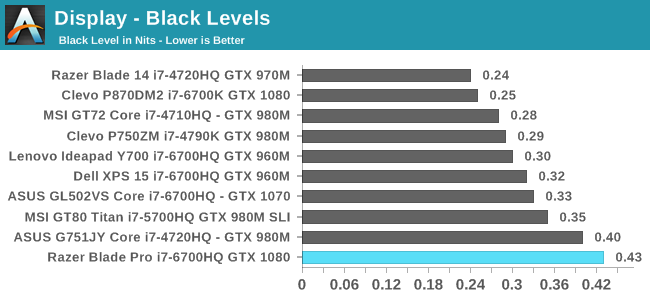
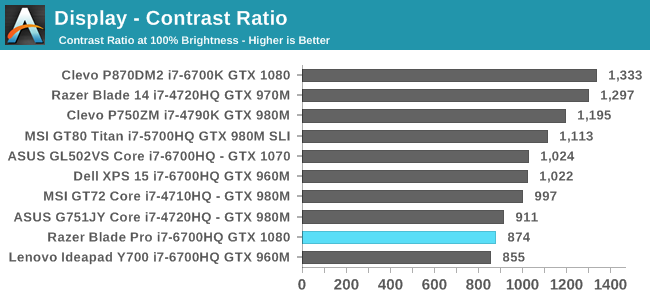
The peak brightness on the Blade Pro is quite good among gaming laptops, but the black level is surprisingly high. The panel razer is using isn't performing as well in this regard as the one used in the smaller 14-inch Razer Blade. I suspect that Razer has little control over this as they need to pick a suitable panel from those that already exist on the market, but it's still disappointing nonetheless.
Greyscale
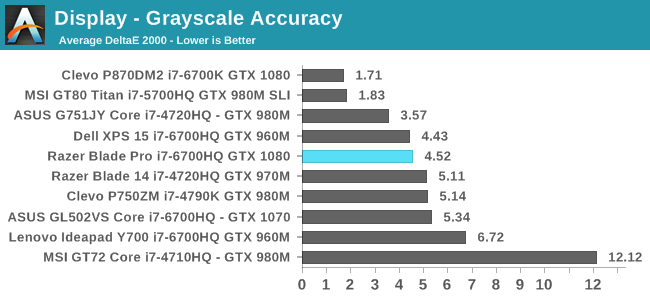
Greyscale accuracy on the Blade Pro is rather poor for such an expensive machine. It's important to note that although this is measuring against sRGB, the white point of D65 and gamma of ~2.2 for our testing doesn't change when testing against Adobe RGB, so this result is applicable to both.
It's clear from the results above that the gamma is too high, with an average value of roughly 2.4 over the entire curve, and a large section where the value is between 2.5 and 2.6. This leads to a generally darker image, as it takes longer for the greyscale to come out of the shadows. However, it would be one thing to have a consistently high gamma, but in this case the issue is both values that are higher than expected and general irregularity in the gamma curve itself.
In addition to the errors caused by the incorrect gamma value at each point, the balance of red, green, and blue components tends towards red for most shades. This causes a noticeable red shift to the display, and the low green component of luminance means that Razer's default calibration actually reduces the display's peak brightness.
The red shifting combined with the irregular gamma leads to a relatively high error level for most shades of grey, with only the very darkest shades providing an acceptable level of accuracy. I honestly don't know what sort of settings Razer was targeting here, because as I mentioned before, these values aren't in line with the spec for sRGB or Adobe RGB, so it's not as though the performance here is going to improve when measuring against Adobe RGB.
Saturation Sweep
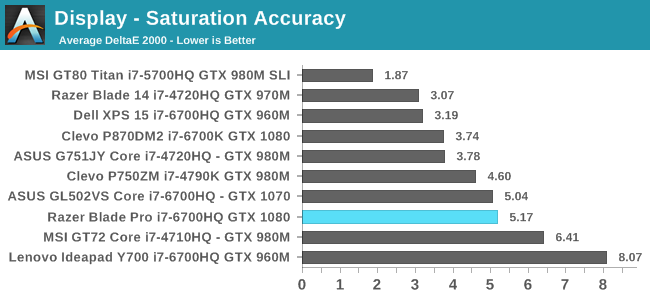
Given that the Blade Pro targets Adobe RGB, it's not surprising to see high error levels for all colors. Even in the case of blue, which has a similar representation for Adobe RGB and sRGB, the red shifting and errors in the gamma throw off the accuracy for all but the deepest levels of saturation. Red is quite inaccurate as well, and green is just hilariously inaccurate, although to be fair, that result is not unintended on Razer's part.
Some readers may be wondering why the errors for red saturation levels are so high even though Adobe RGB and sRGB share the same chromaticity coordinates for red. This highlights one of the limitations of comparing color gamuts using chromaticity diagrams. Although the coordinates for red are the same on the CIE 1976 UCS diagram, the actual CIE XYZ tristimulus values for the colors are not the same. A more simple explanation is that because the green primary in Adobe RGB is significantly more saturated than sRGB, the intensities of red and blue have to be increased in order to maintain the same white representation.
This is fairly intuitive when you think of extending the colors in sRGB. If you represent white in sRGB as (1,1,1), and you increased the saturation of green without corresponding changes to red and blue, your white would start to tend more toward green. Consequently, the appearance of red and blue in Adobe RGB is actually not the same as in sRGB despite the chromaticity coordinates being the same, although in the case of blue the error introduced is on a much smaller scale than for red.
Gretag-Macbeth ColorChecker
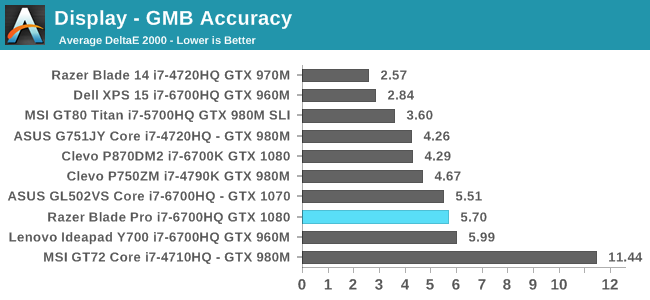
With less than stellar saturation and greyscale accuracy, it's not surprising to see that the Blade Pro struggles to reproduce color mixtures when targeting sRGB.
I really don't have much to say about the Blade Pro's accuracy relative to sRGB, because it was clear to me that it would be poor before I even tested it. If you target one color gamut, you won't be able to correctly reproduce content designed for another color gamut unless you have color management. Windows essentially has no functioning color management, and the few apps that are color managed end up rolling their own solutions or integrating good open source solutions like LittleCMS. Razer should be providing an sRGB color mode much like Microsoft has done on their Surface Studio, which allows proper sRGB color reproduction even with a display that natively has a wider color gamut. If you need sRGB accuracy, the Blade Pro isn't for you.


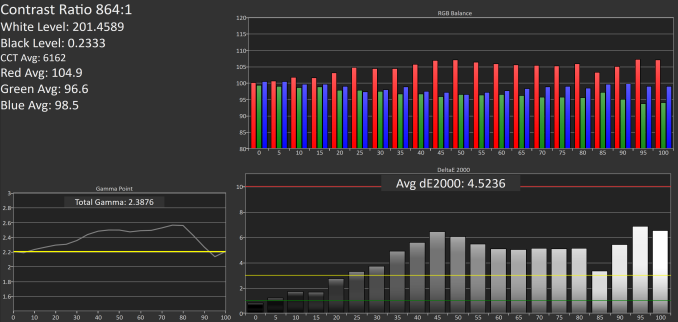
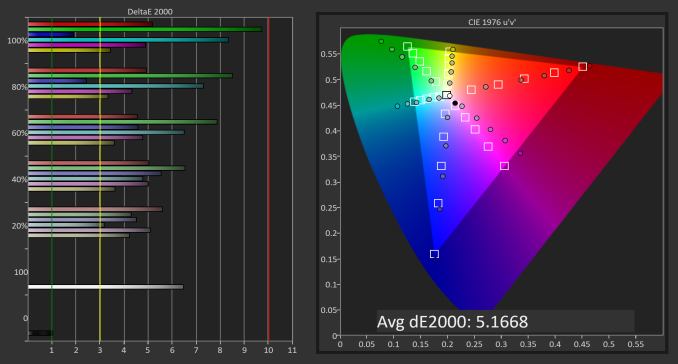








57 Comments
View All Comments
fanofanand - Monday, March 6, 2017 - link
I just wanted to agree with the author on one point, I also have the deathadder and it is the greatest mouse I have ever used for any purpose. It has been beaten on relentlessly and still operates flawlessly. The rest of Razer's products are overpriced garbage (I say that from experience) but their mice are top notch.BrokenCrayons - Monday, March 6, 2017 - link
I hope the current model deathadder chroma lives up to all the hype. I'm buying one as a gift for a certain mmo addict living in my home that's used a cheap Dell mouse to the point where the left mouse button isn't working anymore. I'm genuinely surprised the Dell lasted for so long (5 years) considering how much rage-clicking, grunting, and anger it endured. Even my son wasn't as hard on his mice back in the day when he was young and prone to gamer outbursts.colonelclaw - Monday, March 6, 2017 - link
Plus one for the Deathadder. I've been using them for, I think, over 7 years. In my office I let anyone choose any mouse they like, and over half the staff have gone for a Deathadder. Conversely, for keyboards, no two people have chosen the same (I went for a Corsair K70)BrokenCrayons - Monday, March 6, 2017 - link
Ah thanks for the insight! It's kind of funny this even came up here since I was planning to order one today. It's great to have a few thumbs up on it since it's a present...kind of makes it matter more that it works really well.Don't bury the keyboard yet. :) It's also an OEM Dell board and it's holding up pretty well so far with no complaints. Unlike the mouse, I've not yet heard a complaint about it. I suppose if I ask, I might be opening the door for the next gift though. Haha, it's got to be timed well so it can fall relatively in line with a birthday, Christmas, or Baby Daddy Day yet not close enough to any of those so it can stay a surprise.
SkipPerk - Wednesday, April 19, 2017 - link
I have a death adder and love it as well. I do hate the branding though.Barilla - Monday, March 6, 2017 - link
I'd love to see a review of the Koenigsegg One:1 and the journalist making a comment "but the bulk of the chassis is carbon fiber reinforced polymer, which is still plastic no matter how you put it." ;)I mean, come on. This plastic bashing needs to stop. There are some products made of cheapo plastic that are absolutely terrible, and completely deserve to be called out, but it's not like every plastic product is bad and especially if the plastic we're talking about is carbon fiber.
We use carbon fiber to replace aluminium in hypercars, planes, and spaceships, but suddenly it's not premium enough for a laptop?
Sorry if this reads like an angry rant, but I'm really tired of this notion that everything needs to be made of metal and glass or is otherwise inferior.
Brandon Chester - Monday, March 6, 2017 - link
Let me know when the sensibilities of cars apply to laptops. It's not a coincidence that Razer is the only OEM who can pull off these thermal designs and are also basically the only one making gaming laptops out of aluminum. The material used for the chassis has a significant impact on the thermal profile.BedfordTim - Monday, March 6, 2017 - link
You are right that aluminium is great from a thermal point of view but Barilla has a point that, as long as the thermal are OK, plastic is not inherently a bad design choice. Glass is a terrible material for everything except displays and yet reviewers never criticise it.Murloc - Monday, March 6, 2017 - link
plastic always cracks at some point.BrokenCrayons - Monday, March 6, 2017 - link
Plastic laptops usually survive long enough to provide an adequate service life to the owner. Cracks from fatigue and abuse that do happen sooner often don't adversely impact functionality enough to make a laptop unusable. Its not an ideal material for longevity, but computers have historically been produced with a limited useful lifespan in mind anyway. Although I'd also prefer some metal, in lower priced machines (certainly not the Razer Blade Pro in this review) plastics are a good enough solution.